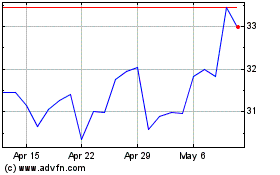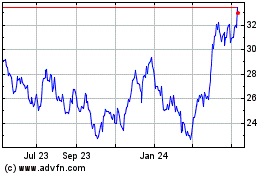Gold ETFs Surge On Fed Outlook - ETF News And Commentary
January 26 2012 - 4:17AM
Zacks
Although the American economy seems to be holding its own to
start the year, significant risks remain to growth. European
worries are always a step away and still high American unemployment
and the potential volatility of the presidential election could
derail stocks at any time. Thanks to this uncertainty coupled with
the lack of inflation in the market, the Fed has seen no reason to
test the market with higher rates, preferring instead to be as
accommodative as possible. Given these trends, the Federal Reserve
announced on Wednesday that it was pushing the prospect of an
eventual rate hike further into the future, now until late
2014.
This move extends their previous pledge by more than a year and
suggests that the Fed believes more sluggish growth levels are
poised to hit the economy over the next few years. The central
bank, however, did not release any plans to expand its bond buying
program but suggested that it will still be ‘highly accommodative’
since the economy is still up against ‘significant downside risks’.
Yet, with that being said, the voting members of the FOMC seem very
split on when the first hike should be. Three asked for one next
year, five in 2014, and the other four members look to have rates
rise in 2015. Thanks to this split and the tilt towards later
years, some believe more easing—QE3—could be coming down the pike
sooner rather than later in another attempt for the Federal Reserve
to jumpstart the lethargic economy (read Three Outperforming Active
ETFs).
With this report, investors pushed yields on T-Bills sharply
lower with the benchmark 10 year note falling to a yield of just
1.91% before rebounding up close to the 2.00% level near the end of
the session. These anemic yields have coupled with the lack of both
more easing or tightening on the horizon to push many into
commodities and stocks instead. While blue chips were up sharply
after the news, arguably one of the biggest winners was in the
commodity space with gold (read Five Cheaper ETFs You Probably
Overlooked).
The yellow metal gained close to $30/oz. in the session before
surging in the final few minutes of the day to soar close to the
$1,711/oz mark—and a near $50/oz. gain—in Wednesday trading. This
key $1,700/oz. level has not been seen in more than a month, and
suggested to some that gold was back on track after its late
December swoon. “The Fed telling us no rate increase to at
least 2014 is a sharp rally promoter for gold, as low interest
rates to continue will make gold a good alternative hold and not
expensive to maintain,” wrote George Gero, a vice president with
RBC Capital Markets, in an emailed note.
As a result major gold tracking ETFs—such as IAU, GLD, and
SGOL—all rose markedly higher after the release, pretty much
matching the gains that front month futures saw in the session.
Beyond commodity ETPs though, the biggest winners were in the gold
equity space as these securities often trade as a leveraged play on
the price of gold. In this space, there are currently four ETFs
including the large cap focused GDX and PSAU which added 6.6% and
4.7%, respectively after the report. Additionally, investors saw
the small cap-centric GDXJ beat all other funds in the space with a
7.6% return on the day, and then finally the Pure Gold Miners ETF
(GGGG) which, ironically, added the least at 4.41% despite only
targeting firms that derive a significant majority of their
production from gold (read Top Three Precious Metal Mining
ETFs).
Meanwhile, in the other key precious metal silver, the report
was having an equally impressive impact on ETF prices. This was
likely due to the fact that silver is also seen as a hedge against
currency debasement but thanks in part to its low price per ounce
and more ubiquitous nature, is often subject to greater price
swings in a short period of time. This means that the white metal
can often outperform on the upside and underperform on the downside
when compared to its more stable gold cousin. This trend also
seemed to be the case today as silver-backed ETFs such as SLV and
SIVR added about 4.14% in the session while the Silver Miners ETF
(SIL) gained nearly 4.6% for the day—barely pacing its underlying
metal in the period (read Time To Consider The Silver Miners
ETF).
Overall, the recent report from the Fed could suggest that gold,
and to a lesser extent silver, have seen a near-term bottom,
especially given how lengthy the period of heavy accommodation will
be in terms of monetary policy. Clearly, the precious metals
markets liked the Fed report so further accommodations from a
monetary perspective, be it in the form of more asset purchases or
bond buying, could add to returns of these ETFs into the future as
well and make the late year slide in the products a distant
memory.
Want the latest recommendations from Zacks Investment Research?
Today, you can download 7 Best Stocks for the Next 30
Days. Click to get this free report >>
Disclosure: Long IAU, gold bullion, and silver bullion.
To read this article on Zacks.com click here.
Zacks Investment Research
Want the latest recommendations from Zacks Investment Research?
Today, you can download 7 Best Stocks for the Next 30 Days. Click
to get this free report
Global X Silver Miners (AMEX:SIL)
Historical Stock Chart
From Apr 2024 to May 2024

Global X Silver Miners (AMEX:SIL)
Historical Stock Chart
From May 2023 to May 2024
